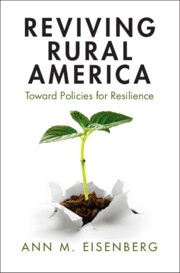Book contents
- Reviving Rural America
- Reviving Rural America
- Copyright page
- Contents
- Figures
- Acknowledgments
- 1 Introduction
- 2 The Foundational Myths
- 3 The Myth of Rural Empowerment
- 4 The Myth of Rural Unsustainability
- 5 The Myth of Rural Decline
- 6 The Myth of Rural Radicalism
- 7 The Myth of Rural Whiteness
- 8 The Myth of Rural Obsolescence
- Index
1 - Introduction
Published online by Cambridge University Press: 20 June 2024
- Reviving Rural America
- Reviving Rural America
- Copyright page
- Contents
- Figures
- Acknowledgments
- 1 Introduction
- 2 The Foundational Myths
- 3 The Myth of Rural Empowerment
- 4 The Myth of Rural Unsustainability
- 5 The Myth of Rural Decline
- 6 The Myth of Rural Radicalism
- 7 The Myth of Rural Whiteness
- 8 The Myth of Rural Obsolescence
- Index
Summary
Many suburban and urban residents spend little time contemplating where their food and energy come from. This chapter begins with the author’s introduction to West Virginia – coal country – in all its complexity. That complexity includes regional domination by fossil fuel interests, environmental and economic degradation, and political conflict, intermingled with the region’s uniquely appealing cultural traditions, natural amenities, and local efforts to fight for a better future, including through labor uprisings, law clinics, and savvy politics. West Virginia serves as an entry point for the book’s broader analysis of the half-truths often told about rural communities generally to justify extraction of rural natural resources for urban consumption. The analytical lens of law and political economy is introduced as the book’s tool to debunk myths about rural communities. Centrally, rural America is not, as we are often told, a product of benign markets operating organically. Rural America is a creature of public creation. The book illustrates how US laws, institutions, and policymakers have created, perpetuated, and justified rural disadvantage. By highlighting the human role in geographic inequality, this search for accountability can help inform a more prosperous, equitable, and resilient future for all, especially in the face of climate change.
Keywords
- Type
- Chapter
- Information
- Reviving Rural AmericaToward Policies for Resilience, pp. 1 - 23Publisher: Cambridge University PressPrint publication year: 2024

